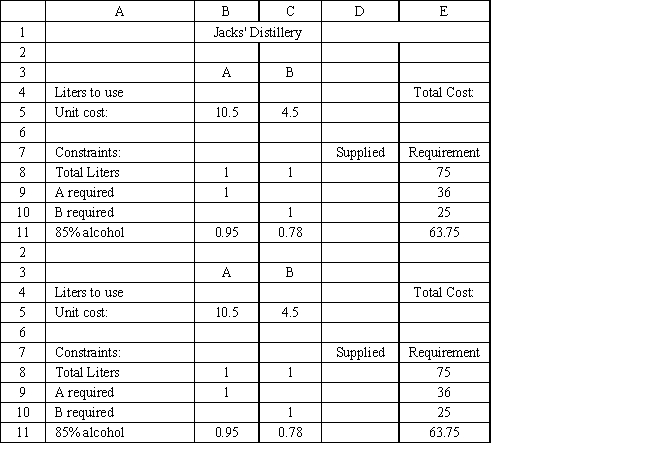Exhibit 3.3
The following questions are based on this problem and accompanying Excel windows.
Jack's distillery blends scotches for local bars and saloons. One of his customers has requested a special blend of scotch targeted as a bar scotch. The customer wants the blend to involve two scotch products, call them A and B. Product A is a higher quality scotch while product B is a cheaper brand. The customer wants to make the claim the blend is closer to high quality than the alternative. The customer wants 50 1500 ml bottles of the blend. Each bottle must contain at least 48% of Product A and at least 500 ml of B. The customer also specified that the blend have an alcohol content of at least 85%. Product A contains 95% alcohol while product B contains 78%. The blend is sold for $12.50 per bottle. Product A costs $7 per liter and product B costs $3 per liter. The company wants to determine the blend that will meet the customer's requirements and maximize profit. 

-Refer to Exhibit 3.3. What formula should be entered in cell E5 in the accompanying Excel spreadsheet to compute total cost?
Definitions:
Dock Warrants
Documents that certify the ownership of goods stored in a warehouse or dock, enabling the holder to take possession or control of the goods.
Dock Receipts
Documents used in the transportation industry that acknowledge receipt of goods by a carrier for shipment.
Security Interest
A legal claim or lien on collateral that has been pledged, usually to secure repayment of a loan.
Debtor
A Debtor is an individual or entity that owes money or has financial obligations to another party, known as the creditor.
Q4: The allowable decrease for a constraint is<br>A)
Q10: Which type of spreadsheet cell represents the
Q10: Refer to the above table. For these
Q41: In mathematical programming formulations the objective function
Q43: An office supply company is attempting to
Q51: Refer to Exhibit 4.1. The Week 1
Q103: The following production possibilities table represents an
Q173: A point inside a production possibilities curve
Q200: Answer on the basis of the relationships
Q220: One of the basic economic defences of